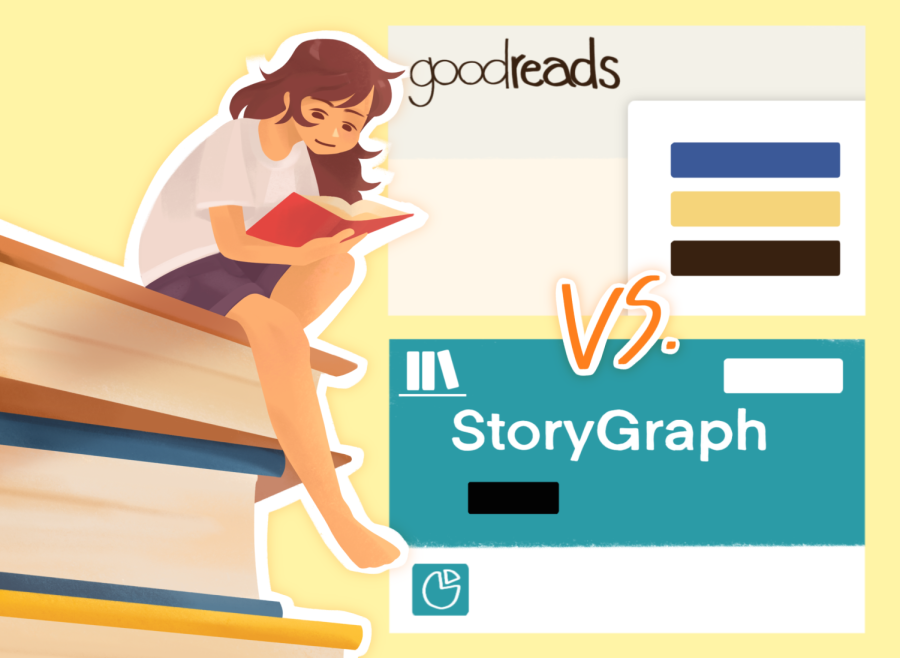Goodreads versus The StoryGraph
For years, Goodreads has held what is essentially a monopoly over the book-tracking market space. Now The StoryGraph has come to challenge this position.
Introduction
For years, Goodreads has held what is essentially a monopoly over the book-tracking market space, where avid readers can find new recommendations and share their passions for reading. This was only further bolstered by its 2013 acquisition by Amazon. But in 2019, Nadya Odunayo founded Goodreads’s most successful challenger yet: an independent, Black- and female-owned app called The StoryGraph, with over 100,000 users and counting. We put these two platforms to the test to see if it’s finally time to migrate.
User Interface
If Goodreads knew what was good for them, they’d update their interface to look a little less beige, brown and blocky. Unfortunately, since the app’s design has barely changed since its 2006 debut, it looks outdated and downright ugly. You’d think they would have the resources to do a design overhaul, especially after Amazon’s purchase. (Alternatively, there are theories that Goodreads’s big tech parent company allows them to ignore user complaints because there will be users anyway.) Regardless, when compared to The StoryGraph’s sleek, minimalistic white background and teal accents, it’s not even a competition.
Shelves
Although Goodreads also includes a To-Read, Currently Reading and Read list, The StoryGraph in addition to this has a built-in Did-Not-Finish shelf and — perhaps most exciting — a shelf called the Up Next Queue. This solves a problem many readers face: having hundreds of books on their To-Be-Read list. With the Up Next Queue, you can pick out a couple of books from your list that you intend to read in the near future.
User Feedback
The StoryGraph wins this category by a landslide. Goodreads is notoriously terrible at addressing users’ complaints or requests for new features — its stagnancy is infamous, particularly its aforementioned outdated interface. Goodreads has a page where people can suggest ideas, but it seems to go largely ignored: When I scrolled through the first 10 or 20 ideas, in the box “Status Update” was … nothing.
The StoryGraph, on the other hand, has this glorious feature they call the Roadmap. It shows you which features and updates are coming when: Coming Soon, This Week, Shipped, Medium Term, Long Term and Ideas. With the Roadmap, I know that language statistics are in the works long-term, that daily reading streaks are coming soon, that Dark Mode and Offline Mode are medium-term and so much more.
Even more exciting is the constant flow of communication, fostered by real interaction between the developers of The StoryGraph and its users. If you have The StoryGraph Plus, you can vote and comment on upcoming features, and request new ones. The developers are active on Roadmap and are constantly asking for feedback or suggestions on a potential new feature or idea, and replying to comments.
The transparency and openness The StoryGraph offers its users is thrilling, indicative of an app that is willing to evolve. The StoryGraph clearly prioritizes the wants and needs of its users, and recognizes the need for change. Trying to get Goodreads to make any updates, in comparison, is like screaming at a brick wall.
Community Building
Goodreads, at least currently, boasts superior community building. In addition to having a larger user base, it also includes more community features: allowing users to create book-related quizzes, clubs and communities; or, through social media tie-ins, find their real-life friends and invite them to Goodreads. The StoryGraph currently only allows users to find other users with similar tastes in books, as well as start buddy reads (track your progress through a book alongside your friends). However, according to The StoryGraph’s Roadmap, importing friends from Facebook and Twitter is a feature that is “Coming Soon.” The ability to post from the StoryGraph to Twitter, and reply to other people’s reviews, are both marked “Medium-term.”
Statistics
The StoryGraph has statistics for your books’ moods, pace, genres and even your most read authors. The app also recently released a year-end feature called the Reading Wrap-Up, which is essentially Spotify Wrapped but for books. It includes exclusive stats like your longest and shortest book, the average time it took for you to finish each book, the average length of your books and which months were better or worse for reading. It even includes how many new authors you read, how many books were part of a series and how many books you re-read. Goodreads, on the other hand, only tells you how many books and how many pages you read. In short, Goodreads is to The StoryGraph what Apple Music is to Spotify.
Reviews
Goodreads wins for the reviews, which is what it is primarily known for. Of course, The StoryGraph has very useful features: quarter and half stars, content warnings and a quiz-like review section on everything from how loveable the characters are to whether the plot is more plot- or character-driven. (Goodreads still only lets you rank by full star, despite a long history of online complaints.)
My biggest problem — and the reason why the StoryGraph didn’t win this section — is the way the app prioritizes its quiz-like review portion over the long-form, written explanations. In fact, it took me nearly half a year to realize that The Story Graph even had written reviews (although that might just be me). Still, the app makes these reviews objectively harder to access than Goodreads.
If I were to look up a book on Google in search of reviews, I’d go to Goodreads first — I don’t think The StoryGraph even shows up as a search result. However, if you don’t like long-form reviews and prefer short-answer style, The StoryGraph is perfect.
Verdict
Ultimately, The StoryGraph wins because it has proven that it is willing to listen to its users. Unless you only use book cataloging sites for the reviews, I’d recommend The StoryGraph over Goodreads any day — it has a cleaner user experience, better-developed features and the ability to import all of your Goodreads data! You (finally) get half- and quarter-star ratings, fun statistics, and developers who actually care about your experience. And, you know … it’s not owned by Jeff Bezos.





